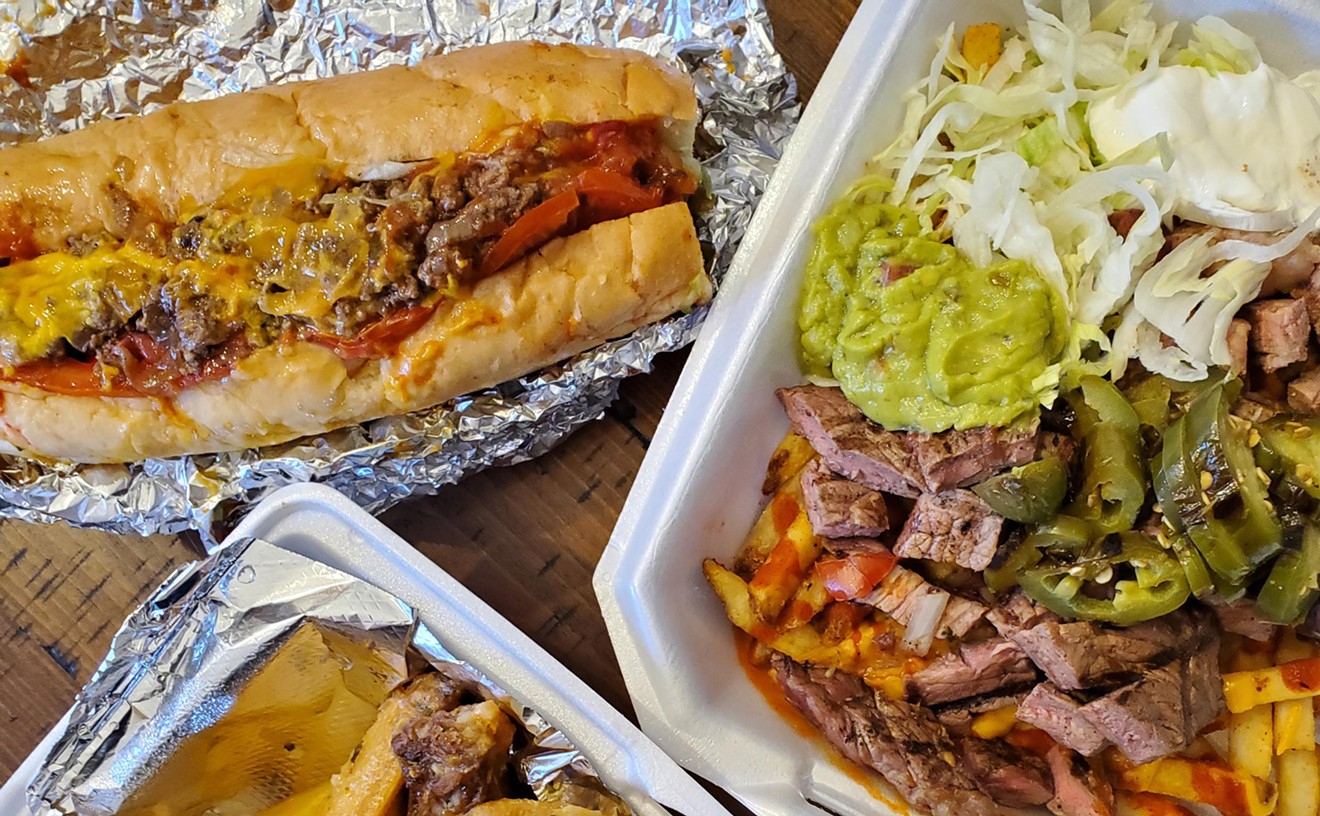The Masters have just moved semi-permanently back to Denver after holding down a kind of dual residency between here and Long Island. And Provence. And occasionally England. They came back with the intention of seeing to their namesake restaurant, Mel's, as it changed chefs, decor, feel. Soon after they settled into their temporary digs, though, the Masters got a call that Piscos was going on the block. "Crazy world, isn't it?" Mel asks.
It was an opportunity they couldn't pass up, since it had everything that Mel and Jane love: history and synchronicity and a sense of fate. Also, it had a dining room that didn't need much structural work, a kitchen that's fully equipped, an address that anchors a still up-and-coming restaurant neighborhood, and the possibility of a quick turnaround between close of contract and opening of doors. Barring any last-minute complications, the deal will be sealed by the end of November, and a new restaurant, Montecito, up and running in early December. "Before Christmas, certainly," Mel tells me, hedging his bets slightly.
Mel will focus primarily on Mel's, and Jane will oversee the five-night service at Montecito. "It's a mom-and-dad kind of thing," Mel explains. "Though Janie will always have input at Mel's and, I hope, I'll have some say at the new place."
No decision has been made on a chef for Montecito, though one may come soon. "There've been two or three good chefs, good names, who've approached us," Mel says. Of that I have no doubt: Over the years, Mel's kitchens -- at Mel's, Starfish, Dudley's, Top Hat and Jams, among others -- have trained or been the proving ground not only for some big international names, but pretty much every name chef working in Denver.
At least the cuisine has been decided. Jane is looking at a California-Mediterranean-styled place, bright and fresh, inspired by the restaurants around the Santa Barbara area (hence the name). "Stylistically, we don't want to be Italian," Mel explains. "We were going to do a Provençal restaurant because of, like, our life in Provence. But that was too, I don't knowŠSo what do you say? People ask you what kind of food it is, and you say what? Contemporary American. You say California-Mediterranean because that has an image of both the bright, simple, good places in California and some of the Italian food they do there. We both have this inevitable description we're asked for. It's getting harder and harder to find a handle, you know?"
Put (a bit) more simply, Montecito will focus on a California regional style, because that region allows you to take influences from many traditions. It can serve Italian dishes without being an Italian restaurant, Southwestern without being Mexican, greenmarket cuisine without having to pay specific homage to Saint Alice and her disciples.
"Anyway," Mel says, "it's going to be good." And then he laughs. "Now all we have to do is get it open."
State of the art: Another volume of a very important book series has just hit the shelves -- the 2006 edition of Best Food Writing. Why is it so important? Because I'm in it, of course. There's other stuff as well, but you know how I am. Me, me, me...
Just kidding. Actually, you can read my story included in Best Food Writing -- "Mama's House," from the January 5 issue, about the night Westword photographer Mark Manger and I spent looking for Mama T's secret Ghanaian house restaurant -- free of charge online. But then you'd be missing the brilliant work of fifty other food writers who aren't me.
This is my fourth year in the collection, and those four years have showcased an interesting stretch of work that comes off like case wines, with good vintages and not-so-good ones. For example, 2003 was a great year, with a piece by Adam Gopnik ("The Cooking Game," originally published in the New Yorker) that's one of my favorite pieces of food writing ever. There were also achingly beautiful pieces from John Haney and Miriam Sauls, and funny ones from Nigel Slater and Jonathan Gold. In 2003, I looked like a punk among champions. It was a year when food writers lived large, spoke loud and really stomped on the terra.
But 2004 and '05 were different. How do I know? Because I looked pretty good in those years -- and it's not like I'd gotten any better at my job or anything. I'm still the same half-bright spastic thug I was the day I threw in the towel, gave up cooking and picked up a pen to pay the rent. It's just that for about two years, food writing took an ugly turn toward journalism and reporting and away from storytelling -- which is the only thing I've ever been all that good at in the first place. There were a lot of articles on the business of cooking, a lot of think pieces on organic and sustainable farming, a lot of very deep and heavy thinking that entirely missed the fun and emotional power of the best writing on food.
But now it's 2006. The economy is looking better, and restaurants are opening again at a rapid clip. The industry is less mired in the molecular gastronomy and deconstructionist nonsense of years past, less plugged up with dingbats preaching a gospel of absolute organic purchasing and reimagined comfort foodery. And once again, I look like the brain-damaged cousin allowed to sup at the grownups' table only out of strained politeness. This year, John T. Edge, a genius of Southern foodways, writes about the Mississippi Delta steakhouse Lusco's right ahead of me, and Gopnik follows me with a neat bit of double portraiture, tagging along after the Brit chef Fergus Henderson and the Frenchman Alain Passard.
The piece after Gopnik's "Two Cooks" is "Southern Exposure," by Todd Kliman (writing for The Washingtonian). And who is Kliman's story about? Our own Bryan Moscatello, formerly of Adega and now cooking at Indigo Landing in Virginia. If you've wondered what became of Moscatello after he fled the mountains for the coast, buy the book. As a matter of fact, even if you don't care about Moscatello, buy the book. This is a good year for food writers, and Best Food Writing contains the best of our best: a sample of Michael Pollan's life-altering book The Omnivore's Dilemma; a long digression on cookbook obsession from Jane Kramer; a chapter from journo-turned-foodie Bill Buford's book Heat (about his experience with Mario Batali and working the line alongside his guys); a piece by Michael Ruhlman from his new book The Reach of a Chef; and a king-hell dose of old-school, drugs-and-punk-rock Anthony Bourdain called "New Year's Meltdown" that's full of bad words and substance abuse and truth about what the business of being a chef is really like at the bottom.
Also not to be missed is This I Believe: The Personal Philosophies of Remarkable Men and Women from the National Public Radio project of the same name, also now out in bookstores. And why am I mentioning this? Because in it -- along with short essays on personal beliefs by the likes of Albert Einstein, John McCain, John Updike, Gloria Steinem, Studs Terkel, Colin Powell and William F. Buckley -- is my essay. About barbecue.
Trust me: I'm just as shocked as you are.
Me, me, me...
Leftovers: The casual, Provençal-style Mateo, at 1837 Pearl Street in Boulder, turns five this month. And what is chef/owner Matt Jansen doing to celebrate? Opening a new restaurant, of course. RaDDa (named after the region in Chianti) is scheduled for a January opening at 1265 Alpine Street (also in Boulder) and, not surprisingly, will feature the cuisine of Italy.
Something of a road-tripping cuisine, actually, drawing from the areas around Florence and Chianti, Tuscany and beyond. A Boulder native who cooked everywhere from Boulder's Laudisio to Santa Monica to Vegas before coming back to Colorado to open Mateo in 2001, for four years Jansen spent every autumn in Florence, working the wine harvests during the day and the restaurants at night. (In addition to his killer resumé, Jansen also has a sommelier's certificate from the Court of Master Sommeliers in London.) RaDDa will be "a real slice of Florence in a real neighborhood setting," Jansen says, with pizzas from a woodburning oven, entrees off the woodburning grills, house-cured meats and local produce. "Now we're just waiting for that million-dollar opening date."
When it comes, Jansen will be ceding the executive chef's position at Mateo to an equally big-name replacement: Don Gragg, who's already been in the house for a few months, easing his way back into daily service after a stint as a personal chef in the south of France. And just guess where Gragg trained in Denver? That's right -- at Mel's, Starfish and Barolo Grill, as well as at Sacre Bleu (where he held an exec's gig), Kevin Taylor's jou jou and Parisi.
Also in Boulder, Eric Skokan (formerly of Alice's Restaurant at the Gold Lake Resort) just opened Black Cat at 1964 13th Street. And Rumbi Island Grill (not to be confused with Dave Query's Rhumba, in the same town) has joined the lineup at the new Twenty Ninth Street development, giving Boulder its first Hawaiian chain restaurant. Based out of Utah. Offering jerk chicken and "Aloha Mango Chicken Salad."
Closer to home, there's action along one of my favorite restaurant rows -- that stretch of Leetsdale Boulevard/Parker Road running through Glendale. Right on the hip of Leetsdale and Alameda, El Potrero has opened in a nice, high-visibility space. The first thing the owners did was hang a big sign. And the first thing that went on that sign, even before the restaurant's name: "100 tipos de tequila." Nothing like giving the people exactly what they want. Over at 909 South Oneida Street, multiple Best of Denver winner California Bakery (the unusually named Eastern European bakery with the city's best piroshki) has gotten a new name -- maybe. According to a sidewalk sign, the place is now California Pizza Chicken Bakery, though the window signs are still calling it simply California Bakery. In any event, the place still has absolutely nothing to do with California and is the city's best example of the multicultural collision between Eastern European baking, French pastry and good old-fashioned American marketing zeal.
After holding down its spot near the University of Denver for more than forty years, the Piccolo's on East Evans has closed. The Paradise Valley Country Club didn't even last a year; Wynkoop Holdings has closed the restaurant, which it opened last fall. But the empire that started with the Wynkoop Brewing Co. still has six other restaurants, all doing well, according to manager Lee Driscoll.










